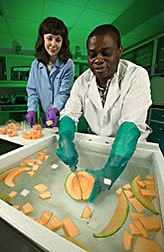|
Read the
magazine
story to find out more. |
|

Chemist Olusola
Lamikanra cuts a cantaloupe under water while food technologist Karen
Bett-Garber prepares the cut samples for analysis. Click the image for more
information about it.
|
With a Good Dunking, Just-Cut Produce Stays
Fresher Longer
By Erin Peabody August
1, 2005
Fresh produce lovers: Put away those paring knives. Thanks to new food
processing technologies being developed by Agricultural Research Service scientists,
there may no longer be a need to engage in all that tedious peeling, chopping,
slicing and dicing.
As Americans are being encouraged to boost their consumption of
colorful fruits and vegetables, ARS researchers are developing methods to
ensure the quality of ready-to-eat produce. Their work will hopefully make it
easier for consumers to get healthy foods.
At ARS'
Southern
Regional Research Center in New Orleans, La., chemist
Olusola
Lamikanra has developed three techniques for prolonging the shelf life of
already-cut fruits and veggies. These methods should help expand the fresh-cut
produce supply, which is already one of the fastest growing food categories in
U.S. supermarkets.
All of Lamikanra's methods center on one goal: keeping plant tissues
from getting stressed out.
When plant cells detect a nearby injury, as occurs with slicing, they
shoot off a flurry of electrical, chemical and hormonal signals. These signals
initiate defense responses that serve to protect the plant. But such wound
signaling also results in noticeable changes to a plant tissue's texture and
chemical properties.
As Lamikanra has found out, one way to bypass the plant's alert system
is to slice the fruit while it's held under water. This way, the plant's
tissues aren't able to detect the changes in pressure that would otherwise
accompany the slicing. The water forms a barrier that prevents the movement of
fluids out of the fruit or vegetable tissues being cut.
Heat and UV light treatments can also be used to fool a plant's
defense system and to keep just-sliced fruit crisper and more flavorful.
ARS food-sensory expert
Karen
Bett-Garber, who leads volunteers in taste tests of cut melon, confirms
that the new methods are helping cantaloupes stay fresh, with their
quintessential melon flavors lasting longer.
To learn more
about this research, see the current issue of Agricultural Research
magazine.
ARS is the U.S. Department of
Agriculture's chief scientific research agency.